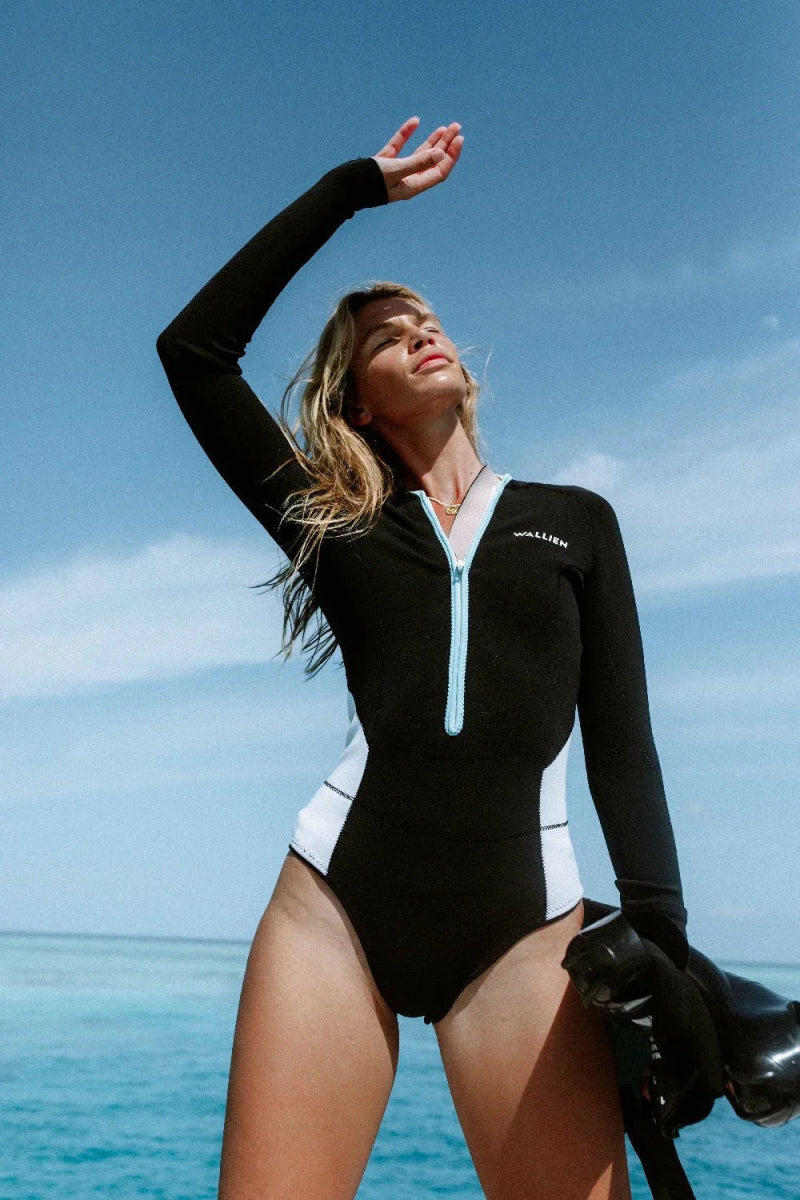
What Is a Springsuit Wetsuit?
|
|
Time to read 4 min
|
|
Time to read 4 min
If you’re into water sports or simply enjoy spending time in the ocean, you’ve likely come across the term “springsuit wetsuit.” But what exactly does it mean? A springsuit wetsuit —often referred to as a shorty wetsuit —is a specialized type of wetsuit designed for mild to warm water temperatures . It typically features short sleeves and short legs , giving you core warmth while allowing your limbs to move freely.
Unlike full wetsuits that provide maximum insulation for cold conditions, springsuits offer a lightweight, more breathable option ideal for spring, summer, and early fall seasons. Whether you're surfing, wakeboarding, snorkeling, or paddleboarding , a springsuit is a popular choice for athletes who need performance and comfort without overheating.
Springsuits offer a variety of features that make them ideal for warmer waters. Here’s what you can typically expect:
Short Sleeve and Leg Design : The most defining characteristic of a springsuit. This design increases flexibility and prevents overheating during high-energy activities.
Neoprene Construction : Like all wetsuits, springsuits are primarily made from neoprene , a stretchy, water-resistant rubber material that provides insulation.
Thickness Range : Most springsuits range from 1mm to 3/2mm in neoprene thickness. This gives you the right amount of warmth for moderate climates.
Types of Zippers :
Back Zip : Easiest to get in and out of.
Chest Zip : Offers better water resistance and flexibility.
Zipperless : Lightweight and extremely flexible but harder to put on.
Flatlock or Glued and Blind-Stitched Seams : These construction methods enhance durability and comfort. Glued and blind-stitched seams are better at keeping water out.
These features combine to create a wetsuit that excels in performance, mobility, and versatility —especially when used in appropriate conditions.
Pros:
Lightweight and flexible – Great range of motion for active water sports.
Ideal for warm weather – Keeps your core warm without overheating.
Easy to put on and take off – Short design makes dressing quick and simple.
More affordable – Generally cheaper than full wetsuits.
Good mobility – Perfect for surfing, paddleboarding, and swimming.
Partial sun protection – Neoprene covers torso and back.
Cons:
Limited insulation – Not suitable for cold water below 65°F (18°C).
Less coverage – Exposes arms and legs to sun, cold, and abrasions.
Not ideal for long dives – Lacks full-body thermal protection.
Reduced protection – Minimal impact resistance compared to full wetsuits.
Less versatile – Only useful in mild to warm conditions.
A springsuit wetsuit is best used in warmer waters and milder climates , typically where temperatures range between 65°F to 75°F (18°C to 24°C) . They’re perfect for:
Warm Weather Surfing : Keep your core warm while enjoying the freedom to paddle easily.
Snorkeling or Free Diving in tropical waters.
Paddleboarding or Kayaking on sunny days with cool ocean breezes.
Triathlons and Open Water Swims where buoyancy and comfort are crucial.
Beach Days with extended time in the water—offering protection from wind, sun, and slight chills.
Springsuits are also a smart choice when you want some thermal insulation and protection but don’t need the full coverage of a long wetsuit.
Choosing the right springsuit wetsuit depends on a few key factors that influence comfort, warmth, and mobility.
Your springsuit should fit snugly without restricting movement. A close fit around the neck, arms, and thighs helps prevent cold water from flushing in. Try moving your arms and squatting to make sure the suit allows flexibility without discomfort.
Springsuits typically range from 1mm to 3/2mm in thickness.
1–2mm: Best for warm, tropical waters with maximum flexibility.
3/2mm: Slightly thicker for added warmth in breezy or cooler conditions.
Choose the thickness based on the water temperature and your activity level.
Back zip: Easy to put on and take off; good for casual use.
Chest zip: Offers better flexibility and a more secure seal.
Zipperless: Ultra-light and flexible but harder to get into.
Flatlock seams: Breathable, suitable for warm water, but allow some water in.
Glued and blind-stitched (GBS): More watertight, better for cooler conditions.
Well-known brands like O’Neill, Rip Curl, Billabong, and Xcel usually offer better materials, fit, and durability. Consider spending a bit more if you’ll be using your springsuit regularly.
A springsuit wetsuit is the perfect choice for water sports in warm to mildly cool conditions. With short sleeves and legs, it offers a great balance of core warmth, flexibility, and comfort , making it ideal for surfing, swimming, snorkeling, and other active water pursuits.
Lightweight and easy to wear, springsuits are especially popular in spring and summer when full wetsuits feel too warm. While they’re not designed for cold water or deep diving, they shine in environments where mobility and breathability matter most.
If you're looking for a versatile, budget-friendly wetsuit that keeps you comfortable without overheating, a springsuit is a smart addition to your gear. Choose the right thickness and fit, and you’ll be ready to enjoy your time in the water with confidence and ease .
If you want to buy yoga mats or books for beginners, you can check out more on our store
More Springsuit Wetsuits For You
A springsuit provides core warmth, sun protection, and comfort during warm-weather water activities. It’s perfect for surfing, paddling, and snorkeling.
You can, but it’s not recommended. Springsuits are best suited for water temperatures between 65°F and 75°F . For colder water, go with a full wetsuit.
It should fit like a second skin—tight enough to prevent water from flushing through but not so tight that it restricts movement or breathing.
With proper care (rinsing, drying in the shade, and avoiding overstretching), a good-quality springsuit can last 2–4 years or more depending on usage.


